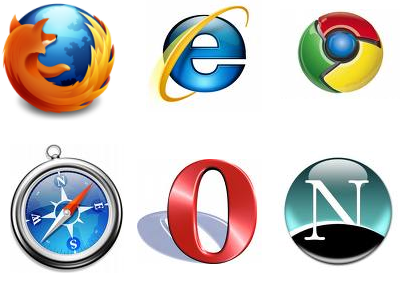INTERNET: THE EVOLUTION
The Internet is a global network of computers and computer networks communicating under one set of guidelines, normally called Transmission Control Protocol/Internet Protocol (TCP/IP).

What is the Internet?
The Internet is not a specific place, company, or service, although places, companies and services are accessible via the Internet. Nobody owns the Internet.
How does the Internet work?
Protocols -standardized rules that define how computers communicate and exchange data
IP address - unique number used to identify computers on the Internet
Domain Name -structured naming system to locate computers on the Internet.
URL-uniform naming scheme that specifies unique address of lnternet resources.
Client and server- computing architecture used by most Internet services
TCP/IP (Transmission Control Protocol / Internet Protocol)
•The internet is a packet-switching network that uses TCP/IP as its core protocol.
•TCP/IP is a suite of protocols that govern network addresses and the organization and packaging of the information to be sent over the Internet.
-TCP-flow controland recovery of packets
-IP- - addressing and forwarding of individual packets.

Internet Protocols
-HTTP (Hypertext Transfer Protocol Protocol)-for accessing and transmitting World Wide Web documents
-FTP (File Transfer Protocol)- for transferring fles from one computer to another
- Gopher Protocol-for accessing docum ments via Gopher menus (no longer widely used)
-Telnet Protocol-allows users to logon to a remote computer
-SMTP (Simple Mail Transfer Protocol) for sending and managing electronic mails (e-mail)
IP address
• IP address is a unique address assigned to each computer connected to the Internet.
• It is used by TCP/IP to route packets of information from a sender to a location on the Internet.
• IP address consist of four sets ofnumbers ranging from 0 to 255 E.g 249.7.13.53
249.7.13.53
• The first two number sets designate the network
• The third number set identifies the local network
• The fourth number set identifies the particular Machine
Domain names
• Domain names are the alias or English language equivalent of a computer's IP addresses
• Domain Name System (DNS) allows the use of easier to remember domain names instead of IP addresses to locate computers on the Internet
• Domain Name Resolvers scattered across the Internet translate domain names into IP addresse
• Domain names are the alias or English language equivalent of a computer's IP
addresses.
• Domain Name System (DNS) allows the use of easier to remember domain names instead of IP addresses to locate computers on the Internet
• Domain Name Resolvers scattered acros the Internet translate domain names into IP addresses Top Level Domains
.edu - educational/academic
.com - commmercial/company site
.gov - government site
.org - non-profit organization
.mil - military sites
.int - international organizations
.net - network providers
UNIFORM RESOURCE LOCATOR (URL)
• Each Internet document or file has a unique address called a URL
• The URLcomprises of three parts:
-Protocol - lets the computer know how to process the information it receives.
-Path - lets the know computer know which directory and file to access
- Domain name - Internet address of the computer hosting the site and storing the document
INTERNET SERVICES AND APPLICATION
We shall look in depth into some internet services and application and their usage and benefit. We shall be considering the following:
• Internet Browser
• Search Engines
• Electronic mail (E-Mail)
• Blogs and Forum.
Internet Browser (Web Browser)
A web browser is a software application for retrieving, presentimg, and travesing
information resources on the World Wide Web. An information resource is identified by a Uniform Resource Identifier (URI) and may be a web page, image, video, or other piece of content. Hyperlinks present in resources enable users easily to navigate browsers to related resources.
Although browsers are primarily intended to access the World Wide Web, they can also be used to access information provided by web servers in private networks or files in file system.
The major web browsers are Internet Explorer, Firefox, Google Chrome, Apple Safai and Opera.

Brief History of Web Browser
The history of the web browser dates back to the late 1980s, when a variety of
technologies laid the foundation for the first web browser, WorldWideWeb, by Tim Berners Lee in 1991. That browser brought together a variety of existing and new software and hardware technologies.
The introduction of the NCSA Mosaic web browser in 1993 - one of the first graphical
web browsers - led to an explosion in web use. Marc Andreessen, the leader of the Mosaic team at NCSA, soon started his own company, named Netscape, and released the Mosaic influenced Netscape Navigator in 1994, which quickly became the world's most popular browser, accounting for 90% of all web use at its peak (see usage share of web browsers).
Microsoft responded with its browser Internet Explorer in 1995 (also heavily influenced by Mosaic), initiating the industry's first browser war. By bundling Internet Explorer with Windows, Microsoft was able to leverage is dominance in the operating system market to take over the web browser market; Internet Explorer usage share peaked at 95% by 2002.
Opera debuted in 1996; although it has never achieved widespread use, having less than 1% browser usage share as of February 2009 according to Net Applications, having grown 2.14% in April 2011 its Opera-mini version has an additive share, in April 2011 amounting to 1.11 % of overall browser use, but focused on the fast-growing mobile phone web browser market, being preinstalled on over 40 million phones. It is also available on several other embedded systems, including Nintendo's Wii video game console.
In 1998, Netscape launched what was to become the Mozila Foundation in an attempt to produce a competitive browser using the open source software model. That browser would eventually evolve into Firefox, which developed a respectable following while still in the beta stage of development, shortly after the release of Firefox 1.0 in late 2004, Firefox (all versions) accounted for 7.4% of browser use. As of April 2011, Firefox has a 21.63% usage share.
Apple's Safari had its first beta release in January 2003; as of April 2011, it has a
dominant share of Apple-based web browsing, accounting for just over 7.15% of the entire browser market.
The most recent major entrant to the browser market is Google's Chrome, first released in September 2008. As of April 2011, it has an 11.94% usage share.
Function
The primary purpose of a web browser is to bring information resources to the user. This process begins when the user inputs a Uniform Resource Identifier (URI for example http://en.wikipedia.org/, into the browser. The prefix of the URI determines how the URI will be interpreted. The most commonly used kind of URI starts with http: and identifies a resource to be retrieved over the Hypertext Transfer Protocol (HTTP). Many browsers also support a variety of other prefixes, such as https: for HTTPS, ftp: for the File Transfer Protocol, and file: for local files. Prefixes that the web browser cannot directly handle are often handed of to another application entirely. For example, mailto: URIs are usually
passed to the user's default e-mail application, and news: URIs are passed to the user 's default newsgroup reader.
In the case of htp, https, file, and others, once the resource has been retrieved the web browser will display it. HTML is passed to the browser's layout engine to be transformed from markup to an interactive document. Aside from HTML, web browsers can generally display any kind of content that can be part of a web page. Most browsers can display images,
audio, video, and XML files, and often have plug-ins to support Flash applications and Java applets. Upon encountering a file of an unsupported type or a file that is set up to be downloaded rather than displayed, the browser prompts the user to save the file to disk.
Information resources may contain hyperlinks to other information resources. Each link contains the URI of a resource to go to. When a link is clicked, the browser navigates to the resource indicated by the link's target URI and the process of bringing content to the user
begins again.
Features
Available web browsers range in features from minima, text-based user interface with bare-bones support for HTML to rich user interfaces supporting a wide variety of file format and protocols. Browsers which include additional components to support e-mail, news, and Internet Relay Chat (IRC), are sometimes referred to as "Internet suites" rather than merely "web browsers".
All major web browsers allow the user to open multiple information resources at the same time, either in different browser windows or in different tabs of the same window.
Major browsers also include pop-up blockers to prevent unwanted windows from ping up" without the user's consent.
Most web browsers can display a list of webpages that the user has bookmarked so that the user can quickly return to them. Bookmarks are also called "Favorites" in Internet Explorer. In addition, all major web browsers have some form of built-in web feed aggregator. In Firefox, web feeds are formatted as "live bookmarks" and behave like a folder
of bookmarks corresponding to recent entries in the feed. In Opera, a more traditional feed reader is included which stores and displays the contents of the feed.
Furthermore, most browsers can be extended via plug-ins, downloadable components that provide additional features.

Types of Internet Browsers:
I will be talking about 4 major types based on user interface, functions, security, features, and speed.
A. Internet Explorer
IE is certainly one of the best browsers for using parental controls. Besides that it is prompt and safe. However, sometimes, it becomes frustrating because of its bewildering security pop-ups.
The best part of working with IE is that it will work with every website. Some of the websites can be only seen on IE otherwise it won't be displayed properly.
B. Mozilla Firefox
After its slow speed initially, the Firefox whiz along and offers better security. It also has a nice looking perceptive interface. It has a nice add-ons facility, so you can pull what you see and add brand new features.
One of its best utility is it's feature that lets you allow downloading YouTube videos on your PC. Firefox is really the ideal choice for the all round purpose by the intermediate user.
C. Google Chrome
The Chrome works on high-powered features and makes them exceptionally easy for the user. Web applications can run in a selected window and feel like a distinctive software. With Chrome, you can also formulate desktop shortcuts that can take you to a full screen version of
what you want on the web.
D. Opera
Opera is the dark horse of the web browsers. It has an amazingly incredible voice command feature through which you can browse the web and Opera reads text to you. You also get a chance to have a look at diversified websites using mouse gestures.
It allows you to browse faster than any other browser. The negative point is that it does not have parental controls and some of the websites are not compatible with Opera, as it is a relatively new browser
E. Safari
Safari shares many of the characteristics with top rated browsers like Firefox and IES. It is therefore, incredible, if you want something swift and spontaneous for Mac. Nonetheless, it lacks in the security and parental control departments.
F. Maxthon
Maxthon works well as far as speed and usability is concerned. You can drag and drop links from other programs, like MsOffice Word right into the browser. Maxthon uses mouse gestures characteristics as well as anti-freeze technology.
You will be able save all of your sides at the end of the session which enables you to start from where you ended. This is a worthy feature, if you have a sporadic browsing. It is extremely reliable, but does not have too many features or add-ons utility. So far, more than 300 people have downloaded it.
G. Flock2
You have the access to Face book, MySpace and Twitter at the same time with this browser. Flock is designed for you to share and receive real life stories through a media bar. It can also track any updates on your social networking sites.
Though Flock is quite secure, but it lacks many other features, like it does not have tabbed browsing, integrated search engine or even a spell checker. It, however, can be utilized as an ideal secondary browser for getting in touch with friends.
Search Engine
A web search engine is designed to search for information on the World Wide Web and FTP servers. The search results are generally presented in a list of results and are often called hits. The information may consist of web pages, images, information and other types of files. Some search engines also mine data available in databases or open directories. Unlike web directories, which are maintained by human editors, search engines operate algorithmically or are a mixture of algorithmic and human input. Web search engines work by storing information about many web pages, which they retrieve from the html itself. These pages are retrieved by a Web crawler (sometimes also known as a spider) - an automated Web browser which follows every link on the site.
Exclusions can be made by the use of robots .txt. The contents of each page are then analyzed to determine how it should be indexed (for example, words are extracted from the titles, headings, or special fields called meta tags). Data about web pages are stored in an index
database for use in later queries. A query can be a single word. The purpose of an index is to allow information to be found as quickly as possible. Some search engines, such as Google, store all or part of the source page (referred to as a cache) as well as infomation about web pages, whereas others, such as AltaVista, store every word of every page they find. This
cached page always holds the actual search text since it is the one that was actually indexed, so it can be very useful when the content of the current page has been updated and the search terms are no longer in it. This problem might be considered to be a mild form of linkrot, and Google's handling of it increases usability by satisfying user expectations that the search terms will be on the returned webpage. This satisfies the principle of least astonishment since
the user normally expects the search terms to be on the returned pages. Increased search relevance makes these cached pages very useful, even beyond the fact that they may contain data that may no longer be available elsewhere.
When a user enters a query into a search engine (typically by using key words), the engine examines its index and provides a listing of best-matching web pages according to its criteria, usually with a short summary containing the document's title and sometimes parts of the text. The index is built from the information stored with the data and the method by which the information is indexed. Unfortunately, there are currently no known public search engines that allow documents to be searched by date. Most search engines support the use of the boolean operators AND, OR and NOT to further specify the search query. Boolean operators are for literal searches that allow the user to refine and extend the terms of the search. The engine looks for the words or phrases exactly as entered. Some search engines provide an advanced feature called proximity search which allows users to define the distance between keywords. There is also concept-based searching where the research involves using statistical analysis on pages containing the words or phrases you search for.
As well, natural language queries allow the user to type a question in the same form one would ask itto a human.Asite like this wouldbe ask.com. The usefulness of a search engine depends on the relevance of the result set it gives back. While there may be millions of web pages that include a particular word or phrase,
some pages may be more relevant, popular, or authoritative than others. Most search engines employ methods to rank the results to provide the "best" results first. How a search engine decides which pages are the best matches, and what order the results should be shown in, varies widely from one engine to another. The methods also change over time as Internet usage changes and new techniques evolve. There are two main n types of search engine that have evolved: one is a system of predefined and hierarchically ordered keywords that
index by analyzing texts it locates. his second form relies much more heavily on the computer itself to do the bulk of the work.
Most Web search engines are commercial ventures supported by advertising revenue and, as a result, some employ the practice of allowing advertisers to pay money to have their listings ranked higher in search results. Those search engines which do not accept money for
their search engine results ake money by running search related ads alongside the regular search engine results. The search engines make money every time someone clicks on one of these ads.
The world is gradually or has already become a global village because of the internet good write up keep is up